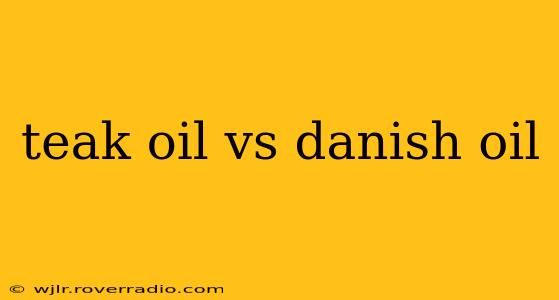Choosing the right oil for your wood finishing project can be daunting, especially with so many options available. Two popular choices often compared are teak oil and Danish oil. While both offer protection and enhance the beauty of wood, they differ significantly in their composition, application, and ultimate effects. This comprehensive guide will delve into the key differences between teak oil and Danish oil, helping you make an informed decision for your next woodworking project.
What is Teak Oil?
Teak oil, contrary to its name, isn't actually extracted from teak trees. It's typically a blend of vegetable oils (like linseed or tung oil) and solvents, designed to penetrate deeply into the wood's pores. Its primary function is to protect wood from the elements, particularly moisture. While it can enhance the wood's natural color, it doesn't generally add a significant sheen or build a protective film on the surface like a varnish or polyurethane.
Advantages of Using Teak Oil:
- Deep penetration: Effectively protects wood from within, making it ideal for outdoor furniture and other items exposed to the elements.
- Water resistance: Provides a degree of water repellency, safeguarding wood from damage caused by moisture.
- Easy application: Relatively straightforward to apply and reapply as needed.
- Enhances natural beauty: Allows the wood's grain and color to shine through.
Disadvantages of Using Teak Oil:
- Not a durable surface finish: Doesn't offer the same level of scratch and abrasion resistance as other finishes.
- Requires frequent reapplication: Needs to be reapplied more often than other types of finishes to maintain protection.
- Can darken wood over time: The oil's darkening effect may not be desirable for all projects.
- Not suitable for all wood types: May not be as effective on certain wood species.
What is Danish Oil?
Danish oil is a blend of drying oils (like linseed oil, tung oil, or soybean oil), varnish, and solvents. Unlike teak oil, which primarily penetrates the wood, Danish oil forms a thin, protective film on the surface while also penetrating to some degree. This results in a more durable and water-resistant finish compared to teak oil.
Advantages of Using Danish Oil:
- More durable than teak oil: Provides better protection against scratches, abrasion, and spills.
- Water resistance: Offers better water repellency than teak oil, providing more protection against moisture damage.
- Provides a subtle sheen: Adds a soft luster to the wood's surface.
- Relatively easy application: Generally straightforward to apply, though multiple coats are often recommended.
Disadvantages of Using Danish Oil:
- Less penetration than teak oil: May not penetrate as deeply into the wood, offering less protection in extremely harsh conditions.
- Requires more careful application: Requires more attention to avoid uneven application and runs.
- May not be suitable for all applications: Not as effective for extremely harsh outdoor environments as teak oil (in some cases).
Teak Oil vs. Danish Oil: Which is Right for You?
The choice between teak oil and Danish oil depends largely on the project and desired outcome:
-
For outdoor furniture or items exposed to harsh weather: Teak oil, due to its deep penetration, offers superior protection against moisture damage. However, it will require more frequent reapplication.
-
For indoor furniture or projects requiring a more durable finish: Danish oil provides better protection against scratches and spills, offering a more substantial protective layer.
-
For projects where a subtle sheen is desired: Danish oil's ability to create a thin film on the wood's surface produces a more noticeable sheen than teak oil.
-
For projects that need significant water resistance: While both offer some protection, Danish oil generally provides better water repellency.
What is the difference between wiping varnish and Danish oil?
This is a common question as both create a similar look. Wiping varnish is a type of varnish thinned with mineral spirits or other solvents, applied with a rag. The key difference lies in durability. Wiping varnish offers significantly more durable protection and a harder surface than Danish oil, which is more of a penetrating oil finish.
Can I use Danish oil on outdoor furniture?
While Danish oil provides some water resistance, it's generally not recommended for outdoor furniture that will be exposed to extreme weather conditions. The thinner film is less resistant to prolonged exposure to rain and UV rays compared to teak oil. For outdoor use, teak oil or a more durable exterior-grade finish is preferred.
How often should I reapply teak oil or Danish oil?
The frequency of reapplication depends on the wood type, the environment, and the level of exposure to the elements. Teak oil typically requires more frequent reapplication (every 6-12 months or even more often for heavily used outdoor furniture) compared to Danish oil, which might last a year or more, depending on conditions.
By carefully considering these factors and understanding the differences between teak oil and Danish oil, you can select the optimal finish to protect and enhance your woodworking creations. Remember that proper preparation and application are crucial for achieving the best results regardless of the type of oil you choose.
